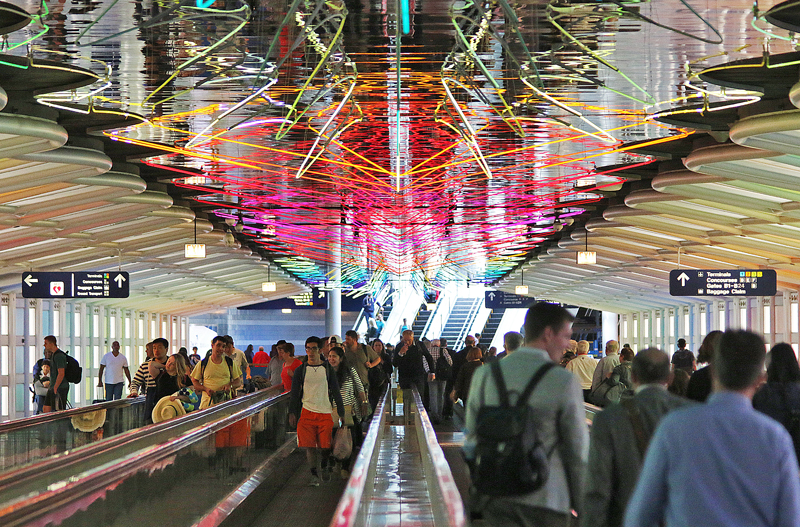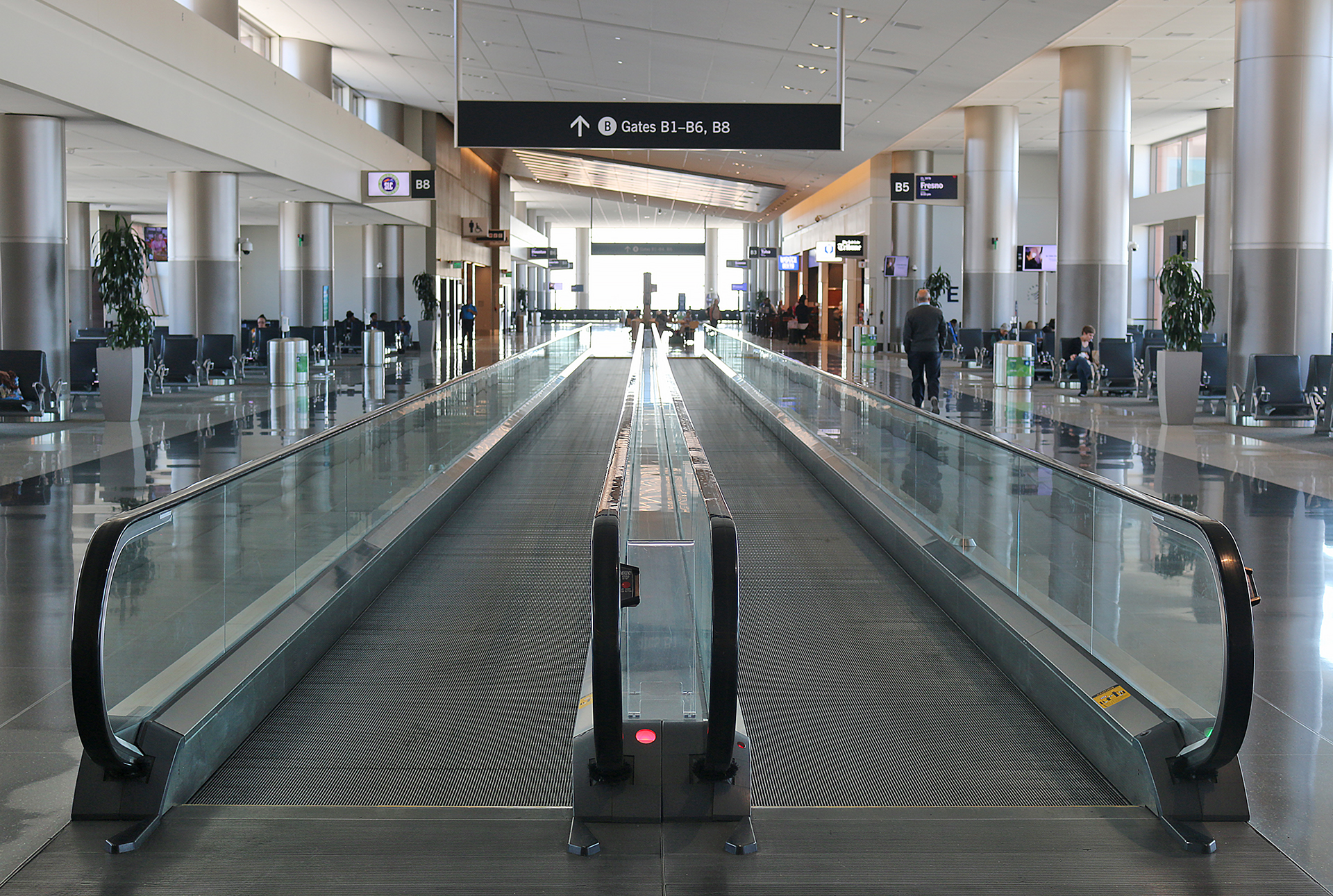Note: This article pertaining to How to Safely Use Escalators and Travelators was originally published on Friday, June 30, 2023 at 8:03 in the evening and has been updated.
Don Mueang International Airport in Bangkok was the scene of a woman whose leg was forced to be amputated after it was stuck in a moving walkway called a travelator on Thursday, June 29, 2023 — which prompted the question of how to safely use escalators and travelators.
How to Safely Use Escalators and Travelators

Travelators are common in airports around the world — especially those airports where getting from the entrance to the gate seems to take forever to the point where passengers may wonder why no flights operated between entering the airport and the furthest gates of that airport — so finding out about a woman who lost a leg after tripping over her suitcase using a moving walkway on her way to the airplane can be rather frightening.
The woman — who is 57 years old and remains anonymous at the time this article was written — is shown in photographs in a sitting position, with her left leg wedged underneath the travelator. Next to her was her pink suitcase, which had lost two wheels; while yellow comb plates which are typically found at the end of travelators had also broken off.
“Is it to avoid flip flop sandals? What actually happens? Does shoe get pulled in so the leg goes under, too? Should one not step on the interface?” derek — who is a reader of The Gate With Brian Cohen — asked in the Comments section of this article pertaining to whether you should travel with a carbon monoxide detector. “Consider an article about this.”
According to this publication from September of 2013 from The National Institute for Occupational Safety and Health of the Centers for Disease Control and Prevention of the United States, “Incidents involving elevators and escalators kill about 30 and seriously injure about 17,000 people each year in the United States, according to data provided by the U.S. Bureau of Labor Statistics and the Consumer Product Safety Commission. Elevators cause almost 90 percent of the deaths and 60 percent of serious injuries. Injuries to people working on or near elevators — including those installing, repairing, and maintaining elevators, and working in or near elevator shafts — account for 14 (almost half) of the annual deaths.”
Although they are basically similar in construction, escalators become steps when on an incline and pose similar risks to moving walkways. The aforementioned report mentions escalators but not travelators; and what comprises those approximately 17,000 injuries is unclear.
Safety Recommendations From Two Manufacturers of Moving Walkways

Schindler Elevator Corporation is one of the manufacturers of moving walkways; and these safety tips for escalators can also be applied to travelators and moving walkways:
- Watch the direction of the moving step and step on and off with extra care.
- Take care if you are wearing bifocals or similar eyewear.
- Hold children firmly with one arm or hold child’s free hand.
- Hold small packages firmly in one hand, but always leave one hand available to hold the handrail.
- Grasp the handle as you step onto the moving step.
- Do not go in the opposite direction of the escalator.
- Do not take wheelchairs, electric scooters, strollers, hand carts, luggage carts or similar items on the escalator.
- When riding escalators: Keep loose clothing clear of steps and sides.
- Wear closed-toed and hard-soled shoes, and avoid wearing footwear made of soft-resin or other rubbery materials.
- Stand clear of the sides of the escalator.
- Face forward and keep firm grip on the handrail.
- Reposition your hand slowly if the handrail moves ahead or behind the steps.
- Don’t climb onto or ride the handrail.
- Do not let children sit on steps or stand too close to sides.
- When exiting escalators: Don’t hesitate and step off promptly.
- Make sure to step over the comb fingers; don’t let your feet slide off the end of the escalator.
- Immediately move clear of the escalator exit area; don’t stop to talk or look around since other passengers may be behind you.
In an attempt to prevent accidents and injuries from happening, the following safety features are added to escalators and moving walkways:
- Sensors to trigger automatic shutdown if a component is outside of its normal position
- Skirt brushes to help prevent objects from being caught in the escalator
- Handrail motion detectors
- Step integrity monitors
- Missing step monitors
- Combplate detectors
- Step level monitors
- Skirt switches
- Emergency stop buttons
- Controlled stop braking
- Understep lighting
- Yellow combfingers
- Handrail guards
Otis Worldwide is another one of the manufacturers of moving walkways; and these safety tips for escalators and moving walkways include:
- When entering escalators and moving walkways, follow these guidelines.
-
- Don’t ride with canes, walkers, carts or wheeled vehicles, including strollers.
- Don’t ride barefoot or with loose shoelaces.
- On escalators, watch the direction of the moving steps, and enter only when steps are going in the proper direction.
- Step on and off with caution. Take extra care if you are wearing bifocals.
- Hold children firmly with one hand.
- Hold small packages firmly in one hand.
- Grasp the handrail as you step promptly onto the moving step or walkway.
- Do not touch the sides below the handrail.
- Keep loose clothing clear of steps and sides.
- Don’t use an inoperative escalator as a stairway.
- Don’t use an escalator to transport freight.
- If you are uncomfortable boarding or riding an escalator, use the elevator instead.
- When riding escalators and moving walkways, follow these guidelines.
-
- On escalators, stand in the center of the step and face forward.
- On moving walkways, stationary passengers should stay to the right and let those walking pass on the left.
- Keep feet away from the sides.
- Keep a steady grip on the handrail.
- Don’t rest your handbag or parcels on the handrail.
- Pay attention to the moving walkway — don’t be distracted by your surroundings.
- Don’t lean against or over the sides.
- Don’t run.
- Never sit on the escalator step or moving walk.
- Parents, make sure children ride in a proper manner.
- When exiting escalators and moving walkways, follow these guidelines.
-
- Step off promptly.
- Don’t hesitate. Immediately move clear of the exit area — don’t stop to talk or look around. Other passengers may be behind you.
Final Boarding Call

Attending to your portable electronic device while on an active moving walkway is not exactly the smartest thing to do if you want to prevent yourself from being injured.
The woman will be compensated by management at the airport — who said that they were “deeply saddened” by the incident — for the partial loss of her left leg, as well as cover her medical expenses.
In order for escalators and moving walkways to operate, a space must exist between the moving parts and the stationary parts — and that is one of the pain points of these machines. Another is the comb plates or comb fingers at the end of the moving walkway or escalator. Users of these devices must respect their potential for causing significant injury by following the aforementioned safety tips and advice on how to safely use escalators and travelators.
I personally cannot imagine the horror and pain of what that unidentified woman experienced…
All photographs ©2017 and ©2023 by Brian Cohen.

